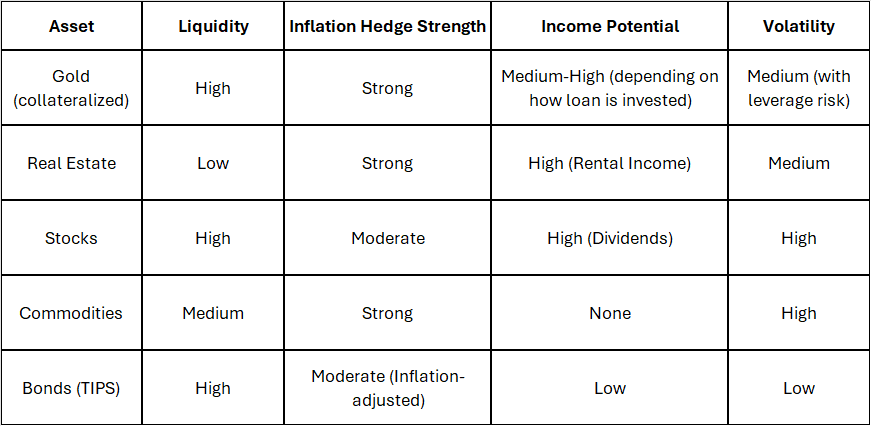Turning Gold into a Dynamic Asset
As a time-tested safe haven, gold serves as a key asset for hedging against inflation and economic uncertainty. However, a powerful strategy allows gold holders to unlock liquidity without sacrificing ownership—using gold as collateral to generate income. This approach transforms gold from a passive store of value into a dynamic tool for wealth-building.
Gold’s Traditional Role: A Hedge Against Inflation
Gold’s primary function has long been to hedge against inflation and currency devaluation. During periods of economic uncertainty, gold prices tend to rise as investors turn to its stability. While currencies can lose value during inflationary spikes, gold maintains its intrinsic worth.
However, gold alone does not generate income. Unlike real estate, which provides rental income, or stocks, which pay dividends, gold is a store of value rather than a cash flow generator. This makes it ideal for wealth preservation, but less useful for generating regular returns.
Unlocking Liquidity: Gold as Collateral
A strategic way to unlock gold’s value without selling it is by using it as collateral for loans. This approach allows investors and business owners to access liquidity while retaining ownership and benefiting from gold’s appreciation. The liquidity can be reinvested in revenue-generating opportunities, providing both cash flow and growth potential.
- For example, a high-net-worth individual or business owner holding a significant amount of physical gold can borrow against the gold through a financial institution, which may offer a loan-to-value (LTV) ratio of up to 75% of the gold’s market value. The funds can be deployed into business ventures that generate revenue, such as expanding operations, purchasing equipment, or launching strategic initiatives. Alternatively, the funds may be invested in income-producing assets like dividend-paying stocks or real estate. Meanwhile, the gold remains in secure storage, maintaining its role as a hedge against inflation and economic uncertainty.
Income Generation through Leverage
Using gold as collateral provides a unique opportunity to generate income. Financial institutions generally offer competitive terms for loans secured by gold, allowing investors to use the capital to generate returns while keeping the gold asset. With interest rates often pegged to benchmarks like SOFR plus 3%, this strategy can create a favorable spread if the investment returns exceed borrowing costs.
Balancing Risk and Reward
While this strategy enhances the income-generating potential of gold, it introduces an element of risk. Borrowing against gold involves financial leverage, which can amplify both returns and losses. If the investment underperforms, the borrower must still service the loan. Additionally, if gold prices fall, lenders may require more collateral, adding financial pressure. Evaluating interest rate spreads, cash flow projections, and potential returns ensures that the loan aligns with long-term business goals.
Comparison to Other Assets
This strategy positions gold as a more competitive asset compared to traditional inflation hedges like real estate, stocks, and commodities.
- Real estate, while an excellent inflation hedge, is less liquid and often requires significant management.
- Stocks offer dividends but can be volatile, particularly in inflationary environments.
- Commodities may rise with inflation but can be volatile and less liquid than gold.
By using gold as collateral, investors can combine the inflation protection of gold with the income potential of other asset classes. This allows for a balanced portfolio that benefits from both stability and growth.

Comparing gold as collateral with other income generating assets
Transforming Gold into a Dynamic Asset
Using gold as collateral offers a unique way to unlock the value of this timeless asset. By leveraging gold’s liquidity, investors can generate income while retaining the long-term benefits of gold ownership. This strategy transforms gold from a static store of value into a dynamic, productive part of a diversified portfolio, balancing both security and growth potential.
Disclaimer: This article is for informational purposes only and should not be considered financial or investment advice. The strategies discussed involve risks, including the potential for financial loss. Before making any investment decisions, consult with a qualified financial advisor or professional to assess your specific financial situation and goals.



